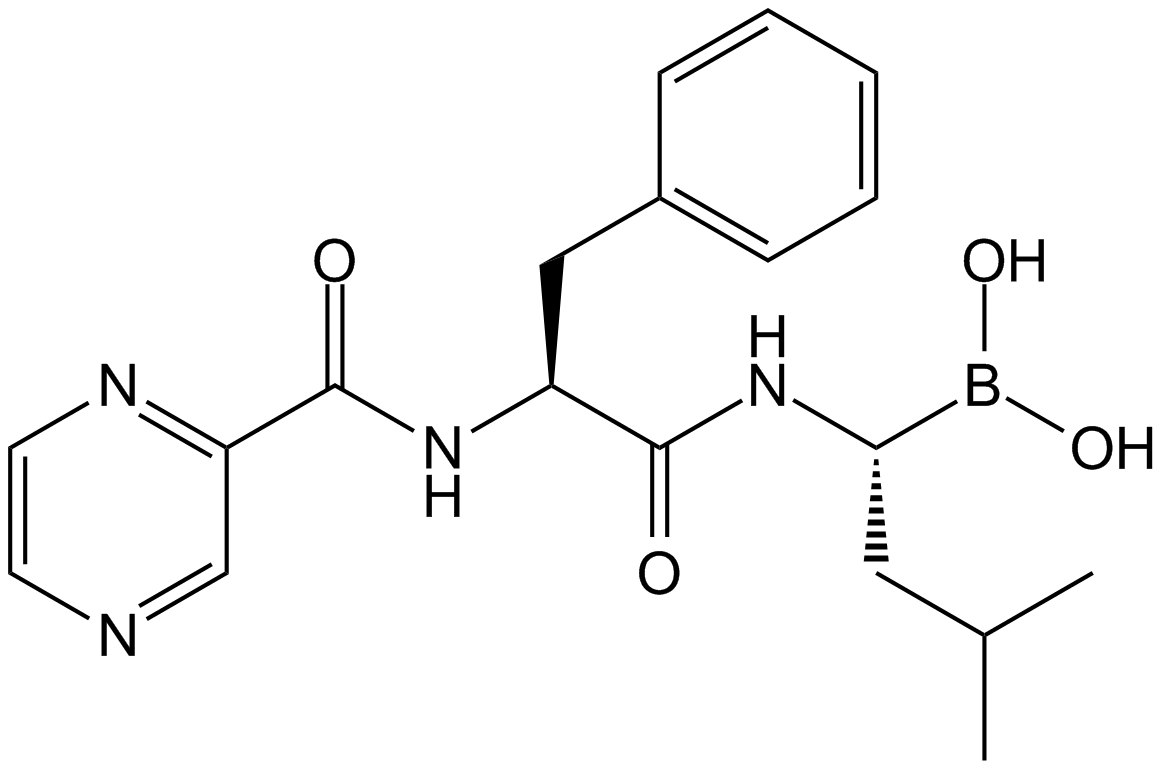Bortezomib (PS-341) (Synonyms: LDP-341, MG-341, MLN341, NSC 681239, PS-341) |
| カタログ番号GC17644 |
強力で可逆的な20Sプロテアソーム阻害剤
Products are for research use only. Not for human use. We do not sell to patients.

Cas No.: 179324-69-7
Sample solution is provided at 25 µL, 10mM.
Bortezomib (PS-341), as a dipeptide boronic acid proteasome inhibitor with antitumor activity, can potently inhibiit 20S proteasome with Ki of 0.6 nM by targeting a threonine residue[1].
In vitro, Bortezomib can retain NF-kappaB in the cytoplasm and inhibit cell growth with IC50 of 22.5 nM, in a dose/time-dependent way[2]. Bortezomib inhibited growth and induced apoptosis of PEL (primary effusion lymphomas) cell lines with IC50 values of 3.4-5.0 nM[3].
In vitro, 1 µmol/L-10 nmol/L bortezomib can activate the Akt pathway via increased SRC-3 (Steroid receptor coactivator-3)[4]. In vitro, 20 nM bortezomib induces apoptotic cell death and promotes G0/G1 phase arrest[5].
In vivo, BALB/c mice were treated with 1 mg/kg bortezomib intraperitoneally once weekly for 2 weeks increased phosphorylation of JNK (c-Jun N-terminal kinase) and extracellular signal-regulated protein kinase (ERK) in the spinal cord[6]. In vivo, mice were treated with bortezomib (2 mg/kg, i.v.) on Day1 and Day4 each week for continuous 4 weeks. bortezomib-treated mice showed enhanced mechanical hyperalgesia, decreased tail nerve conduction and sciatic nerve demyelination[7].
[1] Adams J, et al. Proteasome inhibitors: a novel class of potent and effective antitumor agents. Cancer Res. 1999 Jun 1;59(11):2615-22.
[2] Galimberti S, et al. PS-341 (Bortezomib) inhibits proliferation and induces apoptosis of megakaryoblastic MO7-e cells. Leuk Res. 2008 Jan;32(1):103-12.
[3] An J, et al. Antitumor effects of bortezomib (PS-341) on primary effusion lymphomas. Leukemia. 2004 Oct;18(10):1699-704.
[4] Ayala G, et al. Bortezomib-mediated inhibition of steroid receptor coactivator-3 degradation leads to activated Akt. Clin Cancer Res. 2008 Nov 15;14(22):7511-8.
[5] Bao X, et al. Bortezomib induces apoptosis and suppresses cell growth and metastasis by inactivation of Stat3 signaling in chondrosarcoma. Int J Oncol. 2017 Feb;50(2):477-486.
[6] Tsubaki M., et al. Trametinib suppresses chemotherapy-induced cold and mechanical allodynia via inhibition of extracellular-regulated protein kinase 1/2 activation. Am. J. Cancer Res. 2018;8:1239-1248.
[7] Wu Z, et al. Lysosomal dysfunction in Schwann cells is involved in bortezomib-induced peripheral neurotoxicity. Arch Toxicol. 2023 May;97(5):1385-1396.
References:
Average Rating: 5 (Based on Reviews and 30 reference(s) in Google Scholar.)
GLPBIO products are for RESEARCH USE ONLY. Please make sure your review or question is research based.
Required fields are marked with *




















